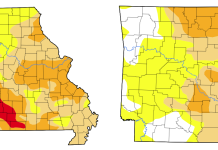With the strong possibility of severe storms and damaging winds and tornadoes expected throughout portions of Missouri and Arkansas, the American Red Cross wants to remind everyone to take a moment to get prepared.
HOW TO STAY SAFE: Individuals are encouraged to download the free Red Cross Emergency App to receive emergency alerts and information about what to do in case of thunderstorms, flooding and other disasters, as well as locations of shelters. The app also includes emergency first aid information and a Family Safe feature which allows people to instantly see if loved ones are okay. The free emergency app is available in app stores by searching for the American Red Cross or going to redcross.org/apps.
TOP TORNADO PREPARATION TIPS : Identify a safe place in your home where household members and pets will gather during a tornado: a basement, storm cellar or an interior room on the lowest floor with no windows.
- In a high-rise building, pick a hallway in the center of the building. You may not have enough time to go to the lowest floor.
- In a mobile home, choose a safe place in a nearby sturdy building. If your mobile home park has a designated shelter, make it your safe place. No mobile home, however, it is configured, is safe in a tornado.
KNOW THE DIFFERENCE:
- A tornado WATCHmeans a tornado is possible.
- A tornado WARNINGmeans a tornado is already occurring or will occur soon. Go to a safe place immediately.
THUNDERSTORM SAFETY STEPS
- If thunder roars, go indoors. If you can hear thunder, you are close enough to be in danger from lightning.
- Postpone outdoor activities if thunderstorms are likely to occur.
- If a severe thunderstorm warning is issued, take shelter in a substantial building or in a vehicle with the windows closed. Get out of mobile homes that can blow over in high winds.
- Avoid electrical equipment and telephones. Use battery-powered TVs and radios instead.
- Shutter windows and close outside doors securely. Keep away from windows.
- Do not take a bath, shower or use plumbing.
- If you are driving, try to safely exit the roadway and park. Stay in the vehicle and turn on the emergency flashers until the heavy rain ends. Avoid touching metal or other surfaces that conduct electricity in and outside the vehicle.
- If you are outside and cannot reach a safe building, avoid high ground; water; tall, isolated trees; and metal objects such as fences or bleachers. Picnic shelters, dugouts and sheds are NOT safe.
- If someone has been struck by lightning, call 9-1-1 or the local emergency number. Anyone who has sustained a lightning strike requires professional medical care.
FLOOD SAFETY
- Turn around, don’t drown. If driving, turn around and go another way. If you are caught on a flooded road and waters are rising rapidly around you, get out of the car quickly and move to higher ground. Most cars can be swept away by less than two feet of moving water.
- People living in communities threatened by flooding should keep informed about weather conditions and listen to the advice of local officials.
- Follow evacuation orders. Stay away from floodwaters. If you come upon a flowing stream where water is above your ankles, stop, turn around and go another way.
- Keep children and pets out of the water.
- Be especially cautious at night when it’s harder to see flood danger.
HOW TO HELP You can help ensure that families don’t face emergencies alone — especially during a pandemic:
- DONATE: Support our Disaster Relief efforts at redcross.org/GivingDay. A gift of any size makes a difference to provide shelter, food, relief items, emotional support and other assistance. Your donation will be part of our annual Giving Day on March 24 to aid families in need across the country.
- VOLUNTEER: Visit redcross.org/VolunteerToday for most-needed positions and local opportunities.
- GIVE BLOOD: If you’re healthy and feeling well, make an appointment at RedCrossBlood.org. Your donation can make a lifesaving difference for a patient in need. As a thank you, those who come to give blood, platelets or plasma on March 15-26 will receive a Red Cross T-shirt, while supplies last.
For more information on preparedness tips, please visit www.redcross.org .






